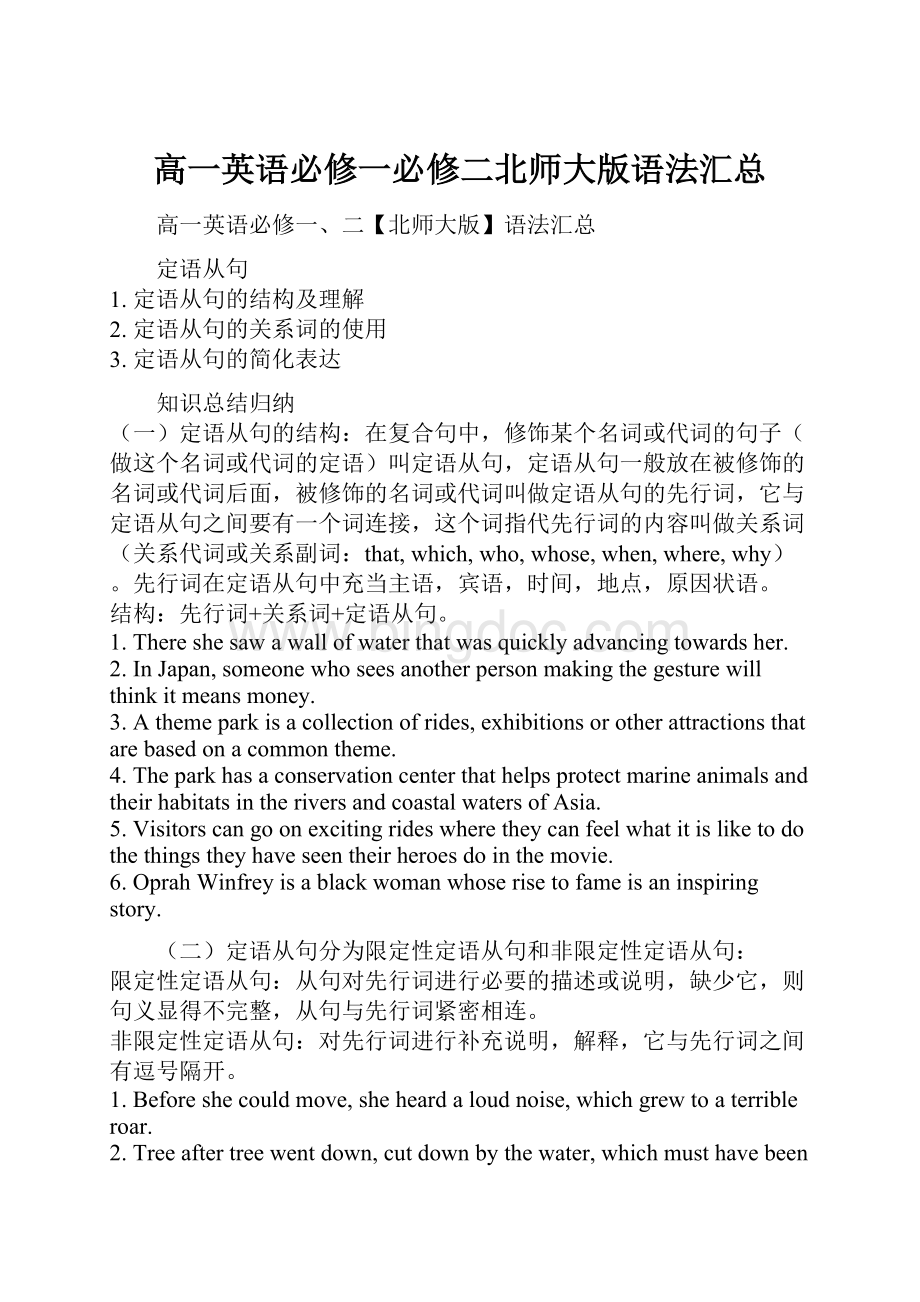高一英语必修一必修二北师大版语法汇总.docx
《高一英语必修一必修二北师大版语法汇总.docx》由会员分享,可在线阅读,更多相关《高一英语必修一必修二北师大版语法汇总.docx(10页珍藏版)》请在冰点文库上搜索。

高一英语必修一必修二北师大版语法汇总
高一英语必修一、二【北师大版】语法汇总
定语从句
1.定语从句的结构及理解
2.定语从句的关系词的使用
3.定语从句的简化表达
知识总结归纳
(一)定语从句的结构:
在复合句中,修饰某个名词或代词的句子(做这个名词或代词的定语)叫定语从句,定语从句一般放在被修饰的名词或代词后面,被修饰的名词或代词叫做定语从句的先行词,它与定语从句之间要有一个词连接,这个词指代先行词的内容叫做关系词(关系代词或关系副词:
that,which,who,whose,when,where,why)。
先行词在定语从句中充当主语,宾语,时间,地点,原因状语。
结构:
先行词+关系词+定语从句。
1.Thereshesawawallofwaterthatwasquicklyadvancingtowardsher.
2.InJapan,someonewhoseesanotherpersonmakingthegesturewillthinkitmeansmoney.
3.Athemeparkisacollectionofrides,exhibitionsorotherattractionsthatarebasedonacommontheme.
4.TheparkhasaconservationcenterthathelpsprotectmarineanimalsandtheirhabitatsintheriversandcoastalwatersofAsia.
5.Visitorscangoonexcitingrideswheretheycanfeelwhatitisliketodothethingstheyhaveseentheirheroesdointhemovie.
6.OprahWinfreyisablackwomanwhoserisetofameisaninspiringstory.
(二)定语从句分为限定性定语从句和非限定性定语从句:
限定性定语从句:
从句对先行词进行必要的描述或说明,缺少它,则句义显得不完整,从句与先行词紧密相连。
非限定性定语从句:
对先行词进行补充说明,解释,它与先行词之间有逗号隔开。
1.Beforeshecouldmove,sheheardaloudnoise,whichgrewtoaterribleroar.
2.Treeaftertreewentdown,cutdownbythewater,whichmusthavebeenthreemetersdeep.
3.Flora,whosebeautifulhairanddresswereallcoldandwet,startedcrying.
4.Theirtalkincludesrhythmandrhymingwordsaswellastonguetwisters,whichoftenmaketheaudienceapplaud.
(三)关系词前面可以根据定语从句的内容加上一些介词,这些关系词在介词后面常用which或whom.
1.TherewasamanwithwhomIwouldhavetoworktogetherandfinallythemanagerofthecompany.
2.Manypeoplewhosawthefilmwereafraidtoswimintheseawhentheyrememberedthescenesinwhichpeoplewereeatenbytheshark.
知识重点与难点
(一)当先行词有最高级,序数词修饰,是不定代词,或是all,no,only等形式时,关系代词一般用that,而不能用which。
1.TheTitanicwasthelargestshipthathadeverbeenbuiltatthattime.
2.Thereisonethingthatkeepsworryingme.
(二)当先行词是表示时间,地点,原因的词时,关系词用when,where,why还有which,that
1.I’mverygladtoreturntomyhometownwhereIhadlivedfor10years.
2.ThisismyhometownwhichIusedtotalkabouttoyou.
3.IthinkIcanunderstandthereasonwhyhedidn’ttellthetruthtome.
4.Noonebelievesthereasonthathegaveusabouthisabsenceatthemeeting.
PPT中关于定语从句有详细解释
(三)定语从句的简化表达:
1.ThemanwhoissittingontheplatformisaprofessorfromWuhanUniversity.
2.Theletterthatwasmailedlastnightwillreachhimtomorrow.
3.Thequestionthatisbeingdiscussedisveryimportant.
4.Youarewelcometoapartytobegiveninourclassat7:
45.
说明:
以上的定语从句部分可以用更加简单的非谓语形式表达出来:
1.ThemansittingontheplatformisaprofessorfromWuhanUniversity.
2.Thelettermailedlastnightwillreachhimtomorrow.
3.Thequestionbeingdiscussedisveryimportant.
4.Youarewelcometoapartytobegiveninourclassat7:
45.
说明:
修饰一个名词除了后面用定语从句以外,还可以用非谓语动词形式:
doing短语,done短语,beingdone短语,tobedone短语修饰。
其结构和意思如下:
1.被修饰名词+doing短语:
正在做….的人/正在发生的事。
2.被修饰名词+done短语:
被…..的人/事
3.被修饰名词+beingdone短语:
正在被…..的人/事
4.被修饰名词+tobedone短语:
将要被…..的人/事
(1)Doyouknowthemantalkingtomysister?
(2)The“crazy”gesture,movingtheindexfingerinacircleinfrontoftheear,means“youhaveaphonecall”inBrazil.
(3)Didyouseethatcarbeingrepaired?
(4)Inacamera,thelensmustbefocusedontheobjecttobephotographed.
(5)Thestudentstoattendthemeetingwillarriveheretomorrow.
(6)GoodsimportedfromabroadarenotalwaysbetterthanthosemadeinChina.
(7)TheYellowRiver,saidtobe“themotherriver”runsacrossChinalikeahugedragon.
总结:
以上做定语的那些短语就是英语语法中所说的分词,不定式的各种形式作定语。
1.这些短语作定语应放在被修饰名词的后面。
如果单独一个V-ing或V-ed形式作定语,则可以放在被修饰名词前面。
2.分词作定语时,其动作应与全句动作同时发生。
V-ing表示主动意义和正在做,V-ed表示被动意义。
beingdone表示正在被做的
3.不定式作定语表示将要发生的,tobedone表示将要被做的
【典型例题】
[例1]Friendshipisneededbyall,_____playsanimportantroleinpeople’slives.
A.whichB.thatC.whoD.it
分析:
_____playsanimportantroleinpeople’slives为非限定性定语从句修饰先行词Friendship用which连接定语从句。
答案:
A
[例2]UncleLi_____Iworkedthreeyearsagohasretirednow.
A.whoB.whomC.withwhomD.towhom
分析:
_____Iworkedthreeyearsago作为定语从句修饰先行词UncleLi,从句完整的表达是:
IworkedwithUncleLithreeyearsago.所以关系词前应加上介词with。
答案:
C
[例3]Isthisthereason_____atthemeetingforhiscarelessnessinhiswork?
A.heexplainedB.whatheexplainedC.howheexplainedD.whyheexplained
分析:
定语从句_____atthemeetingforhiscarelessnessinhiswork修饰先行词thereason指“他在会上就他工作中的粗心解释的原因。
先行词在从句中做宾语。
答案:
A
[例4]Teachers,_____workisratherhard,arebeingbetterpaidthanbefore.
A.whoB.thatC.whichD.whose
分析:
非限定性定语从句_____workisratherhard修饰先行词teachers,它与从句中的work是从属关系,关系词用whose
答案:
D
[例5]TheOlympicGames,_____in776BC,didn’tincludedwomenplayersuntil1912.
A.firstplayingB.tobefirstplayed
C.firstplayedD.tobefirstplaying
分析:
公元前776年被首次举行的奥运会,直到1912年才容纳女运动员。
_____in776BC做定语修饰TheOlympicGames,指过去的内容,表示被动。
用done做定语。
答案:
C
[例6]Thehouses_____fortheteachersandtheconstructionworkwillstartsoon.
A.builtB.tobebuiltC.tobuildD.beingbuilt
分析:
根据句意房子即将开工。
_____fortheteachersandtheconstructionwork修饰Thehouses应为ThehousesThehouses将要为教师和施工修建的房子。
答案:
B
[例7]Howmanyofus_____,ameetingthatisnotimportanttouswouldbeinterestedinthediscussion?
A.attendedB.attendingC.toattendD.haveattended
分析:
根据句意:
比如说,我们当中参加一个对我们毫不重要的会议的人会有多少人对这个讨论感兴趣呢?
_____,say,ameetingthatisnotimportanttous修饰Howmanyofus做定语。
与全句动作同步.
答案:
B
[例8]Shehasthreechildren,_____isworkinginAustralia.
A.whoB.oneofwhomC.oneofthemD.noneofthem
分析:
非限定性定语从句__isworkinginAustralia修饰先行词threechildren,根据从句中的is判断,是说:
三个孩子中的一个在澳大利亚工作。
答案:
B
【模拟试题】
1.Susanistheverygirl_____thegooddeed.
A.whomIthinkdidB.whomIthinkshedid
C.whoIthinkdidD.Ithinkwhodid
2.Luckily,thepoorboyhadenoughmoney_____hecouldbuyatrainticket.
A.bywhichB.onwhichC.withwhichD.forwhich
3.Thebook_____hedevotedmuchtimeistocomeoutnextmonth.
A.whereB.whichC.towhichD.onwhich
4.Thedaycamefinally_____Iwasgivenanopportunitytoactintheplay.
A.whenB.inthatC.whichD.inwhich
5.1.Don’tyouthinkthequestion_____tomorrowisofgreatimportance.
A.beingdiscussedB.discussed
C.tobediscussedD.todiscuss
6.Thefood_____atthemomentisforthedinnerparty.
A.cookedB.tobecookedC.isbeingcookedD.beingcooked
7.Doyouknowtheteacher_____underthebigtree?
A.readB.readsC.readingD.beingread
【试题答案】
1.CSusan正是我认为作了好事的那位女孩。
先行词theverygirl在从句中做think的宾语,同时又是后面宾语从句didthegooddeed.的主语,所以关系词不能用whom
2.C定语从句_____hecouldbuyatrainticket.修饰先行词money:
用这笔钱买火车票。
关系词前面需要加介词:
with
3.C定语从句_____hedevotedmuchtime意思是:
他把大量的时间都投入在这本书上了。
devote….tosth.关系词前加介词:
to
4.A定语从句_____Iwasgivenanopportunitytoactintheplay修饰先行词theday:
先行词theday在从句中做时间状语:
在这一天我得到了扮演一个角色的机会。
5.C短语_____tomorrow做定语修饰thequestion,根据表达的内容:
明天即将被讨论的问题。
应当用不定式的被动结构做定语。
6.D短语_____atthemoment做thefood的定语,表示:
正在做的食物。
Beingdone做定语表示:
正在被……的……。
7.C现在分词短语readingunderthebigtree做定语修饰theteacher表示:
正在大树下看书的那位老师。
情态动词
1.情态动词的推测表达
2.情态动词表达虚拟语气
3.某些情态动词的特殊用法
知识重点与难点总结
知识重点:
情态动词在表达推测意义的句子中的运用:
(一)用情态动词表达事实的推测。
can,could,might,may,must可以用来表达对事实的推测。
根据说话人对事实的把握性大小,must表示“肯定…”,may/might/can/could表示“可能……”,must只用于肯定句中,may/might的否定式maynot/mightnot表示“可能不……”,而can/could可以用于疑问句,表示“可能,可能……吗?
”,其否定式can’t/couldn’t表示“不可能”。
用情态动词可以对现在或过去的事实进行推测。
对不同的时间内容推测有不同的结构。
(二)对现在的事实进行推测:
主要结构:
…must/may/might+动词原形
be+名词/形容词/介词短语
be+doing
例句:
1.YoumustbeJeanne.I’mMathildeLoisel.Weusedtoknoweachotherverywell.
2.Theymustbeinbedalreadyatthistimeofthenight.
3.Theteachermustbejoking.
4.Fredaisn’tinclass.Shemustbesick.
5.Theremustbesomethingwrong.
6.Shemightbeveryclever,butshehasn’tgotmuchcommonsense.
7.Hemaybearrivingthisevening.
8.Hemaybetravelingaroundtheworld.
9.Thekeyscan’tbeintheroom.Ihavejustsearcheditverycarefully.
10.Canthenewsbetrue?
(三)对过去的事实进行推测:
结构:
情态动词+havedone/been+名词/形容词/介词短语
例句:
1.Mrs.Longmansmusthavebeenaprettygirlinheryouth.
2.Hecouldn’thaveseenAnnayesterday.She’sgoneabroad.
3.IthinkImusthaveleftmyglassesinthelibrary.
4.Hemighthaveoversleptagain.
5.WherecanTomhavegone?
情态动词表达虚拟语气:
表达“本来…”,“不然早就…”。
这是情态动词的一种虚拟语气用法。
表示说话人所讲的与所发生的事实相反。
表达了说话人的埋怨,后悔的语气。
其结构是在一些情态动词后面加havedone结构。
根据要表达的意思,有如下结构:
shouldhavedone/oughttohavedone:
本应该……
shouldn’thavedone/oughtn’ttohavedone:
本不该……
couldhavedone:
本来可以……
needn’thavedone:
本来没必要……
wouldliketohavedone:
本来很想……
wouldrathernothavedone:
本来不愿意……
could/might/havedone:
不然早就……
例句:
1.Youshouldn’thavelaughedathismistakes.
2.Youcouldhavetoldusearlier.
3.Ioughttohaveboughtthatdictionarylastweek.
4.Yououghtnottohavespentsomuchtimeinreadingnovels.
5.Weneednothavebeeninatearinghurrytocatchthetrain.
6.Theywouldliketohaveseenthatfilmlastfilm.
7.Ifhehadgivenmehisnumber,Icouldhavetelephonedhim.
8.Theymighthavebeenfrozentodeathbutfortherescueintime.
知识难点:
某些情态动词的特殊用法:
need和dare的两种形式的用法
need和dare可以用做实义动词,后面接不定式(todo)结构,在疑问句和否定句中,加助动词do/does/did/或don’t/doesn’t/didn’t。
作为情态动词使用时,主要用于疑问句和否定句中。
情态动词needn’t(没有必要,不必)相当于don’thaveto
例句:
1.Itiscold,youneedtowearsomewarmclothes.
2.NeedIstayherewithyouforawhile?
Thankyou,youneedn’t.
3.Howdareyouspeaktoparentslikethat?
注意:
句型Idaresay+从句。
意思是:
我肯定……=I’msure或Thereisnodoubtthat+从句。
例句:
IdaresaythatmyunclewillgetthemoneyifIdie.
will和would
表示“意志”或“愿意”,would则指过去愿意做……
例句:
1.Hesaidthathewouldhelpus.
2.Youmaytelephoneifyouwillacceptthisjob.
would可以表达“过去习惯做……”类似于“usedtodo”
例句:
1.Whenwewerechildren,wewoul